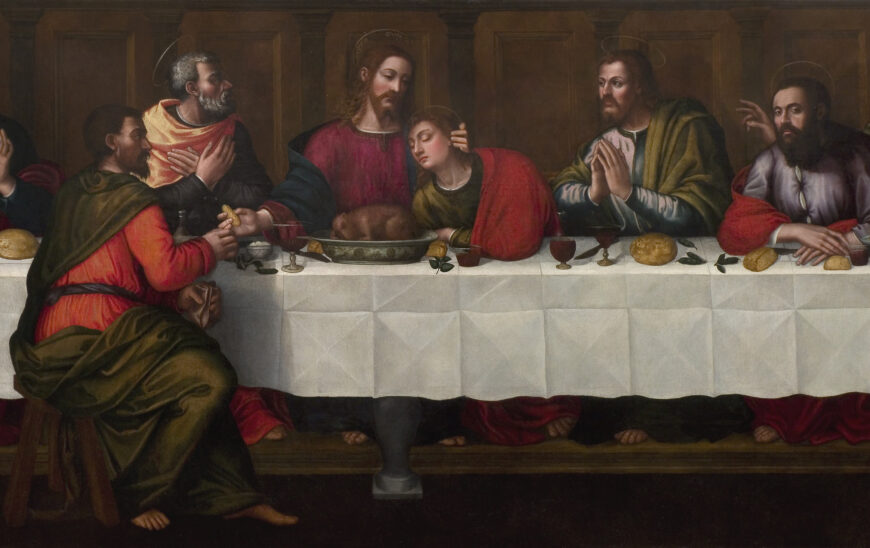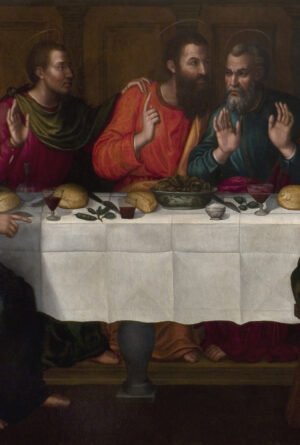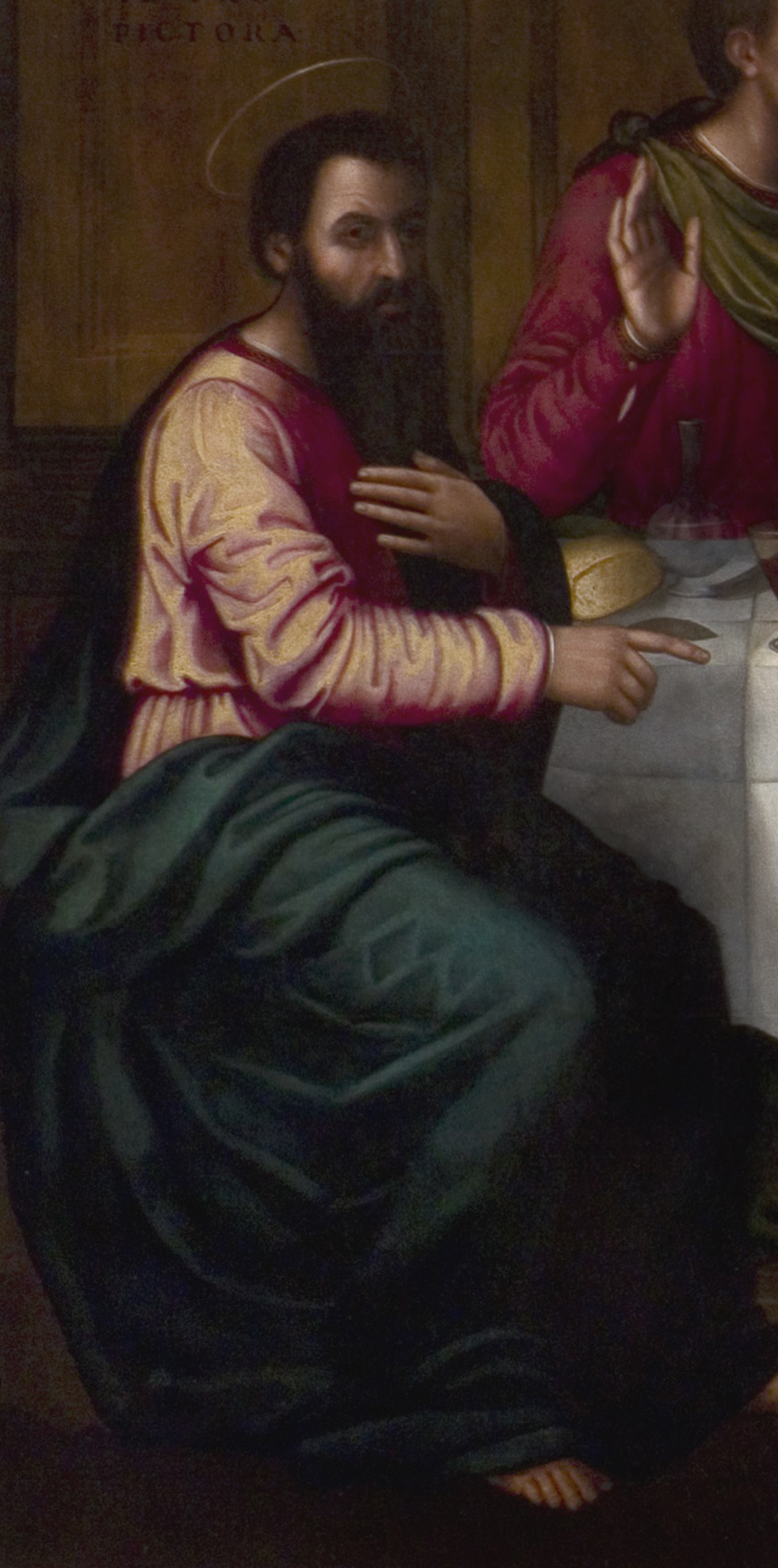
Plautilla Nelli, The Last Supper, c. 1568, oil on canvas, 200 x 700 cm (Santa Maria Novella Museum, Florence)
In the 1990’s the badly damaged and monumental The Last Supper by Florentine painter Plautilla Nelli came to the attention of Advancing Women Artists (AWA), an American non-profit based in Florence that sought to recover forgotten women artists and their artworks. Nelli, a sister and three-time prioress of the Dominican monastery of Santa Caterina in Florence, painted The Last Supper in 1568 for the convent’s refectory. When Santa Caterina, like many other religious institutions, was suppressed under Napoleon in the 19th century, Nelli’s painting was moved to nearby Santa Maria Novella, only to be later removed from its frame, rolled up, and largely ignored for most of the 20th century. AWA fundraised with the “Adopt-an-Apostle” program to facilitate the careful restoration of Nelli’s painting. After four years of restoration, Nelli’s Last Supper was rehung in the Museum of Santa Maria Novella in 2019. Subsequently, Nelli and her paintings have been the focus of numerous exhibitions and publications, finally shining a well-deserved light on the gifts of this painter.
Despite her relative obscurity in the 20th century, Nelli was recognized as a talented painter in her own time. Indeed, she was one of only four women artists that Giorgio Vasari discussed in the second edition of his influential compilation of Renaissance artist biographies, the Lives of the Artists. Vasari praised the nun’s skill, particularly as someone without professional training, and noted that her artworks were prevalent in private collections and sacred sites throughout Florence.


While many Renaissance monastic women made art to fundraise for their convents, Nelli’s creation of large-scale paintings was unprecedented. Santa Caterina’s The Last Supper (measuring about 6.5 x 21 feet) would have required the aid of numerous assistants (likely her fellow sisters) and the construction of scaffolding. While most Florentine Last Suppers made for refectories were done in fresco, Nelli’s is oil paint on canvas, likely because Nelli was self-taught. Though many 16th-century girls and young women were encouraged to dabble with art recreationally, fresco required considerable technical training. As a woman under religious vows, decorum would have prohibited her study in an artist’s studio.

Christ with Judas and John & Chinese porcelain bowls (detail), Plautilla Nelli, The Last Supper, c. 1568, oil on canvas, 200 x 700 cm (Santa Maria Novella Museum, Florence)
Subject & significance
Nelli’s painting depicts the Last Supper—the moment Christ announces to his apostles that one of them has betrayed him, a popular subject for Renaissance refectories in which monastic members would take their communal meals. Shock and dismay reverberate around the group as the haloed men react to the news. Nelli provided visual and iconographic clues to help identify some of the apostles. Notice, for example, that a halo-less figure sits alone on the front side of the table, physically and morally separating him from the rest of the apostles and thus identifying him as the betrayer, Judas. We also see that the traitor clutches a purse of coins in one hand, a reference to Judas’s reward of 30 pieces of silver for betraying Christ to the Romans (John 13:29). With his other hand, the informer reaches for Christ’s proffered piece of bread, another biblical reference alluding to his role in Christ’s inevitable death (John 13:26). In contrast, to the right of Christ, John is so troubled by the pronouncement he leans into the Lord’s breast with his eyes closed, seeking comfort.
During this last meal, Christ also instructed his disciples to partake of the blessed wine and bread as surrogates for his blood and body to nourish themselves spiritually while awaiting his return via resurrection. This was the foundation for the Christian sacrament of the Eucharist, in which followers consume sanctified wine and bread to commemorate Christ’s sacrifice, and to join them physically with the source of life.
Tailoring The Last Supper for Santa Caterina
By the Renaissance, depictions of the Last Supper were largely standardized, especially in central Italy. Like many other artists, including Leonardo da Vinci, Nelli situated the event at a long rectangular table parallel to the picture plane, with Christ at the center surrounded by his twelve apostles. On the cloth-covered table is a relatively modest banquet consisting of the traditional Last Supper meal of wine, bread, and roasted lamb, all symbols and reminders of Christ’s physical sacrifice.

Fava beans and glassware (detail), Plautilla Nelli, The Last Supper, c. 1568, oil on canvas, 200 x 700 cm (Santa Maria Novella Museum, Florence)
In many ways, Nelli’s The Last Supper mirrored the environment of the monastery’s refectory. For example, the nuns sat at long, rectangular tables, taking their communal meals in silence to meditate on spiritual matters, like the subject of the Last Supper. Nelli extended that quiet into the painting. The apostles at their long table react to Christ’s announcement with gestures, body language, and facial expressions, but no one appears to be speaking.
Further, many of the items appearing on the painted table would have been familiar to the sisters’ own meals, encouraging the sense that the painting and its sacred event were an extension of the refectory’s space. For example, records show that like the painting’s Christ and his apostles, Nelli and her nuns had meals consisting of a meat dish (three times a week) and wine, supplemented with a variety of produce. Indeed, convent receipts show the purchase of local fava beans, which Nelli depicted scattered among The Last Supper’s fare, adding a particularly Florentine element to the biblical event. The Last Supper’s leafy greens may have been a symbolic reference to the Seder meal, while also illustrating the practice of some Santa Caterina sisters to deny themselves excessive pleasures of the body by making their meals less palatable with a sprinkling of bitter lettuces. Even The Last Supper’s tableware may have been the monastery’s own. The highly specified glassware emulates styles made in 16th-century Florence.
In contrast to the humble meal, however, are three Chinese bowls adorning Christ’s table. A rare luxury in Renaissance Italy, Chinese porcelain was highly sought after in elite circles—not something we might expect to see in a convent. However, Santa Caterina acquired such grand gifts from the wealthy families of its sisters. By including them in her Last Supper, Nelli was participating in an aesthetic trend inspired by new international trade between China and Europe.

Nelli’s use of cangiante (detail), Plautilla Nelli, The Last Supper, c. 1568, oil on canvas, 200 x 700 cm (Santa Maria Novella Museum, Florence)
Visual qualities & cangiante
Stylistically, Nelli’s painting is consistent with Italian artistic tastes while also meeting the needs of the convent setting. While other regional and contemporaneous Last Suppers (like those of Andrea del Castagno and Domenico Ghirlandaio) include illusionistic backgrounds, decorative details, or even painted onlookers, Nelli’s is focused and simplified to not distract the sisters from the salient points of the sacred image. Set against a simple background of fictive wood paneling, the monumental figures dominate the painting with the saturated, jewel-like colors of their clothing. Gestures, body language, eye lines, and repeated colors draw the viewer’s attention around the scene, but always return the focus to the figure of Christ at the center of the symmetrical composition. While highlights and shadows naturalistically model the forms (look at those drapery folds!), notice Nelli’s use of cangiante. Meaning changing in Italian, cangiante was a coloring mode used by artists like Michelangelo and Raphael, in which volume is indicated not through value contrast (as it is with chiaroscuro), but through the complete changing of color. The result is an illusion of volume with an almost iridescent finish that dazzles the eye. See, for example, how the tunic of Nelli’s left-most apostle shifts from magenta in its shadows to a lemony yellow in the highlights. Or, in the figure to the right of John whose tunic of dark teal lightens to a soft lavender pink.
Nelli’s painting illustrates her knowledge of iconographic traditions and contemporary artistic trends. Simultaneously, she maintained the sacred function of the painting as a means of connecting the viewer to divine matters. In an unusual addition to The Last Supper, Nelli seems to acknowledge her remarkable situation as a successful, untrained female painter under sacred vows by signing the masterpiece with “Orate pro pictura,” or Pray for the Paintress.
Additional resources
Learn more about The Last Supper’s restoration
Learn more about the life of Christ in art
Read about how Smarthistory is expanding the Renaissance
Discover other female artists in the Renaissance
Watch “Medici porcelain, a failed experiment”
Linda Falcone, editor, Visible: Plautilla Nelli and Her Last Supper Restored; Plautilla Nelli e la sua Ultima Cena restaurata (Prato: B’Gruppo Srl, 2019).
Marcia B. Hall, Color and Meaning: Practice and Theory in Renaissance Painting (Cambridge: Cambridge University Press, 1994).
Fausta Navarro, editor, Plautilla Nelli: arte e devozione sulle orme di Savonarola; Art and Devotion in Savonarola’s Footsteps (Livorno: Sillabe, 2017).
Jonathan Nelson, editor, Plautilla Nelli (1524–1588): The Painter-Prioress of Renaissance Florence (Syracuse: Syracuse University Press, 2008).
Ann Roberts, “The Dominican Audience of Plautilla Nelli’s Last Supper,” Plautilla Nelli (1524–1588): The Painter-Prioress of Renaissance Florence, edited by Jonathan Nelson (Syracuse: Syracuse University Press, 2008), pp. 72–83.

